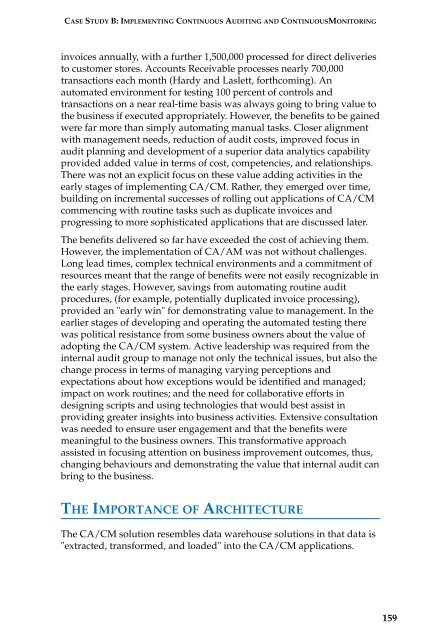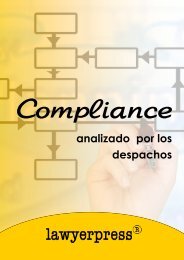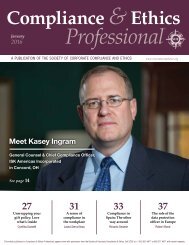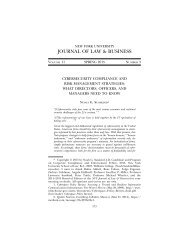AUDIT ANALYTICS AUDIT
x8YaD9
x8YaD9
- No tags were found...
Create successful ePaper yourself
Turn your PDF publications into a flip-book with our unique Google optimized e-Paper software.
CASE STUDY B: IMPLEMENTING CONTINUOUS <strong>AUDIT</strong>ING AND CONTINUOUSMONITORING<br />
invoices annually, with a further 1,500,000 processed for direct deliveries<br />
to customer stores. Accounts Receivable processes nearly 700,000<br />
transactions each month (Hardy and Laslett, forthcoming). An<br />
automated environment for testing 100 percent of controls and<br />
transactions on a near real-time basis was always going to bring value to<br />
the business if executed appropriately. However, the benefits to be gained<br />
were far more than simply automating manual tasks. Closer alignment<br />
with management needs, reduction of audit costs, improved focus in<br />
audit planning and development of a superior data analytics capability<br />
provided added value in terms of cost, competencies, and relationships.<br />
There was not an explicit focus on these value adding activities in the<br />
early stages of implementing CA/CM. Rather, they emerged over time,<br />
building on incremental successes of rolling out applications of CA/CM<br />
commencing with routine tasks such as duplicate invoices and<br />
progressing to more sophisticated applications that are discussed later.<br />
The benefits delivered so far have exceeded the cost of achieving them.<br />
However, the implementation of CA/AM was not without challenges.<br />
Long lead times, complex technical environments and a commitment of<br />
resources meant that the range of benefits were not easily recognizable in<br />
the early stages. However, savings from automating routine audit<br />
procedures, (for example, potentially duplicated invoice processing),<br />
provided an "early win" for demonstrating value to management. In the<br />
earlier stages of developing and operating the automated testing there<br />
was political resistance from some business owners about the value of<br />
adopting the CA/CM system. Active leadership was required from the<br />
internal audit group to manage not only the technical issues, but also the<br />
change process in terms of managing varying perceptions and<br />
expectations about how exceptions would be identified and managed;<br />
impact on work routines; and the need for collaborative efforts in<br />
designing scripts and using technologies that would best assist in<br />
providing greater insights into business activities. Extensive consultation<br />
was needed to ensure user engagement and that the benefits were<br />
meaningful to the business owners. This transformative approach<br />
assisted in focusing attention on business improvement outcomes, thus,<br />
changing behaviours and demonstrating the value that internal audit can<br />
bring to the business.<br />
THE IMPORTANCE OF ARCHITECTURE<br />
The CA/CM solution resembles data warehouse solutions in that data is<br />
"extracted, transformed, and loaded" into the CA/CM applications.<br />
159








